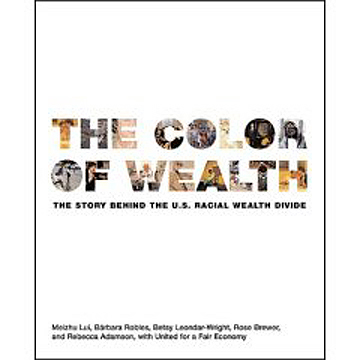The Color of Wealth
Shannon Gibney writes on "The Color of Wealth" by Rose Brewer, who teaches at the University of Minnesota.


“The wealth gap is a profound problem for democracy here in the U.S.,” says University of Minnesota professor Rose Brewer. “A lot of people have studied the income gap, and how that has been closing post-Civil Rights Movement, but there has been far less attention paid to the persistent and growing wealth gap between Whites and people of color.”
Brewer, who writes and teaches in the African American and African Studies Department on the Twin Cities campus, said that uncovering and exploring this issue was the major catalyst for creating The Color of Wealth: The Story Behind the U.S. Racial Wealth Divide, a comprehensive volume which The New Press brought out last year.
“We had been talking about this book for quite some time, and once we decided that we would do it, it took around five years to assemble,” said Brewer. The Color of Wealth’s authors hail from disparate parts of the country, and also have disparate racial and ethnic backgrounds, but they share a commitment to creating and sustaining an economically just society.
Meizhu Liu is executive director of United for a Fair Economy, a Boston-based organization that works for economic parity in all communities; Barbara Robles is an expert in Latino public policy and is currently at work on her book Rich Latino/Poor Latino: Wealth Inequality, Cultural Capital and Social Policy; Betsey Leondar-Wright is UFE’s communications director and a long-time economic justice organizer and researcher; and Rebecca Adamson is founder and president of First Nations Development Institute (1980) and founder of First Peoples Worldwide (1997). All five authors, including Brewer, are active members of UFE, which played a leading role in the book’s development.
The Wealth Disparity Has Uncle Sam’s Endorsement
At the center of The Color of Wealth is the idea that the government — not individuals, not families, not the business community – has played the biggest role in creating and maintaining the wealth gap. The authors write: “For every dollar owned by the average white family in the United States, the average family of color has less than one dime. Why do people of color have so little wealth? Because for centuries they were barred by law, by discrimination, and by violence from participating in government wealth-building programs that benefitted white Americans. Understanding the roots of the racial wealth divide will lead to more understanding of racial inequalities in general and more understanding of how to reach equality.”
This quote begins the book, setting a sober and disturbing tenor for following chapters, which examine the wealth disparity through the lens of the collective histories of Native Americans, African Americans, Latino Americans, Asian Americans, and White Americans. Some key facts Lui, Robles, Leondar-Wright, Brewer, and Adamson take note of include:
• “…federal policy toward Native Americans…has both systematically removed assets from Native American ownership and also reduced control of assets that they rightfully own;
• “African slavery produced the initial start-up capital for what would ultimately become the basis for capitalism in the United States;
• “…the most significant reason for the lack of wealth mobility among Latinos has its roots in government policies toward immigration based on the political philosophies of manifest destiny and the Monroe Doctrine;
• “…the [1790 Naturalization Law was] used to designate immigrants from one Asian country after another as nonwhite, which kept them from wealth-building opportunities offered to white immigrants only, the future citizens of the United States;”
• “White Americans typically have assets more than ten times greater than Americans of color. This difference was created not only by government policies that impeded wealth building for people of color, but also by policies that actually boosted white wealth – policies like land grant and homestead programs, low-cost mortgages, farm loans, and Social Security checks, all at times available only or mostly to white people.”
Needless to say, this is difficult reading to fully absorb, so reading just 20 pages at a time may be advisable, especially to avoid seeing red, which will undoubtedly happen if you are a person of color. Relief does come in The Color of Wealth’s last chapter, however, where the authors lay out a concrete and systematic program for eradicating the gap: invest in education in all communities, fix the income disparity, promote asset accumulation, assist in leveraging and preservation plans, and more.
“The response to the book has been amazing,” said Brewer. “I have been giving talks, readings, and having discussions about it all over. I think people are hungry for this information, which corroborates what they have been seeing in their own communities. People want to take real action towards change, and this book shows them how they can do that.”
Check out The Color of Wealth at your local library or bookstore.
Visit United for a Fair Economy at www.faireconomy.org.